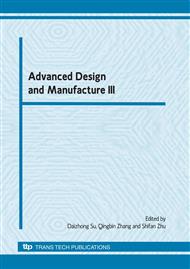p.235
p.239
p.243
p.247
p.251
p.255
p.259
p.263
p.267
A Taguchi-Neural-Based In-Process Tool Breakage Monitoring System in End Milling Operations
Abstract:
The use of CNC machines is one of the successful factors in the computer integrated manufacturing (CIM). Even though the CNC machine can automatically perform the machining processes, some of the situations that may significantly influence the quality of product such as a cutting tool breakage. Therefore, to prevent the machine from damaging and ensure the quality of product, it is important to develop a system that can monitor the tool conditions. The purpose of this study is to develop a Taguchi-neural-based in-process tool breakage monitoring system in end milling operations that can monitor the tool conditions and immediately response a proper action. For an in-process tool breakage monitoring system, a neural network was applied to making decisions of monitoring. One of the disadvantages of neural network is the training processes. It is difficult to determine an optimal combination of training parameters of neural networks. Traditionally, the try-and-error method is time-consuming and without systematic base. Therefore, the optimization of training parameters for neural networks using Taguchi design was applied to training the neural network model and to enhance the accuracy of the tool breakage monitoring system.
Info:
Periodical:
Pages:
251-254
Citation:
Online since:
November 2010
Keywords:
Price:
Сopyright:
© 2011 Trans Tech Publications Ltd. All Rights Reserved
Share:
Citation:


